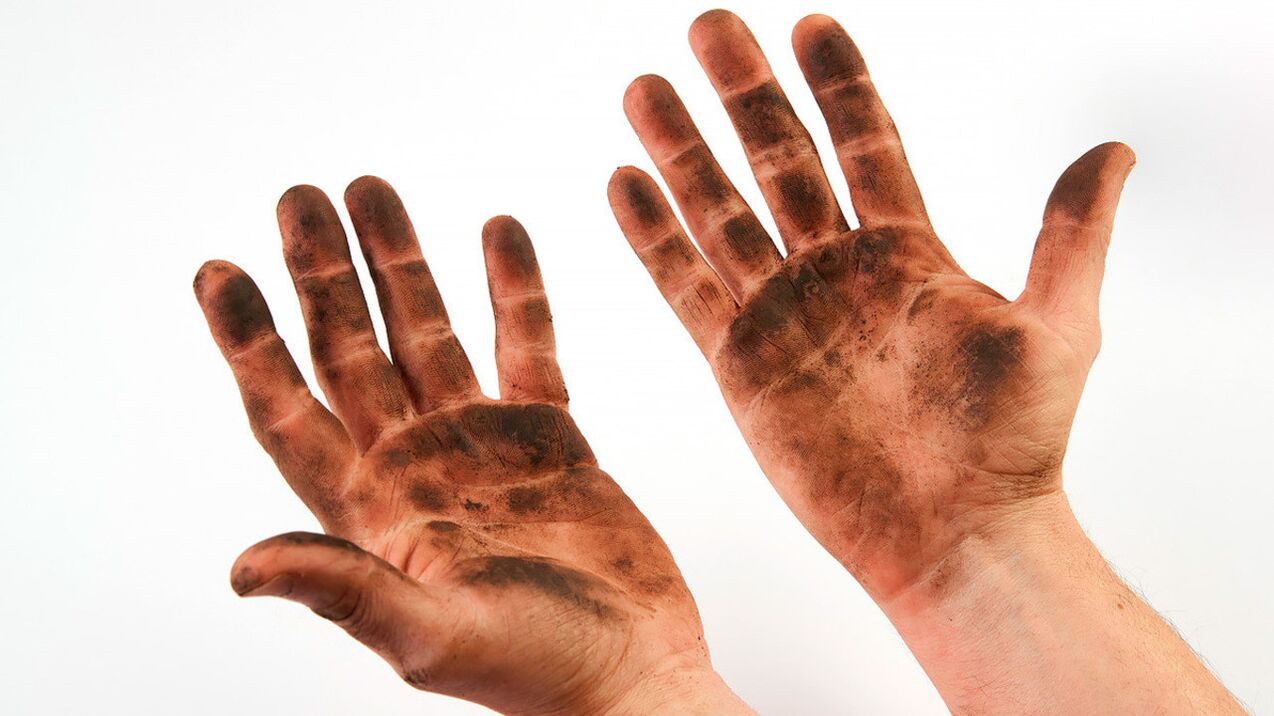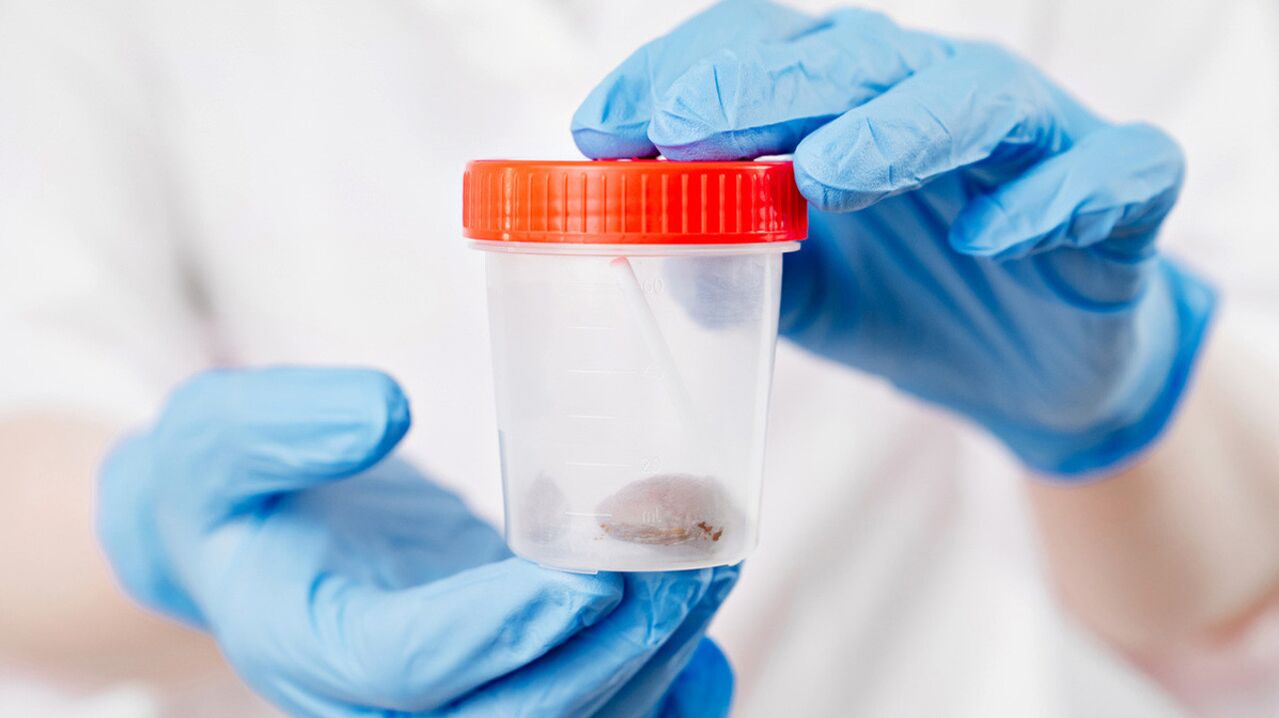%20in%20the%20hands%20of%20a%20doctor.jpg)
Worms are parasitic worms that live in the bodies of humans and animals. They are difficult to detect because they mask many other diseases and conditions. Symptoms of helminthic infection range from mild weakness to fainting with severe intoxication. We will tell you where you can get worms and how to get rid of them.
What is
Worms are considered the most common parasites in humans. Today, science knows about 300 worms. The most common are intestinal worm diseases - enterobiasis and ascariasis, which affect more than 2 billion people.
The size of worms living in the body varies from a few millimeters to a few meters. For example, the length of the pinworm that causes enterobiasis does not exceed 1 cm. Some ribbons (for example, a wide ribbon) reach 12-15 meters.
Causes of helminthiasis
Helminthiasis is a disease in which a worm infection occurs. Worms enter the human body and remain there. These parasites live not only in the intestines but also in other organs and tissues.
According to the World Health Organization, every fourth person on Earth is infected with worms. At the same time, WHO experts note that the actual number of infected is at least 50%. This mainly applies to countries with a low sanitary culture (these are some countries in Africa and Southeast Asia). In other countries, more than 1. 5 million cases of helminth infection are reported annually. Most of them are children.
How can you get infected with worms?
There are 4 ways of infection:
- Through the ground. Such diseases are called geohelminthiasis. Unwashed fruit can contain tens of thousands of parasites. That’s why it’s so important to wash your vegetables, fruits and hands thoroughly before eating. Walking pets are another source of terrestrial parasites.
- In contact with an infected person. Parasitic worms are incredibly prolific. In just one day, a female pinworm can lay up to 5, 000 eggs in the human body. Eggs and adults can be transmitted to other people through bedding and other household items. After that, it is infected enough not to wash your hands and the worms will penetrate inside.
- When you eat contaminated food. Such helminthic diseases are called biohelminthiasis. You can catch parasites with insufficient heat treatment of meat, poultry or fish.
- Through insect stings. This type of transmission is rare. As a rule, very small parasites can be transmitted by insect bites.
Consider risk factors that increase the likelihood of worm infection in adults and children:
- Do not follow hygiene rules - if you do not wash your hands after the street, in the toilet or before eating.
- The habit of biting your nails - there is a lot of dirt with microorganisms and parasites under them. This also includes the habit of taking pens, pencils and other objects in your mouth.
- Poor pet care, especially for those who go outside.
- Eat unwashed vegetables and fruits.
- Use of water from suspicious sources.
- Poor cleaning of the living space.
- Passion for animal feed that has not undergone proper culinary processing.
Who is in danger

No one is immune to worm infection. It is enough to relax in hygiene matters, and the larva of the parasite can "break through" into the body. The following categories of people are particularly susceptible to helminthiasis:
- Little kids. The most common helminthic invasions have been reported in children. This is due to the fact that the child neglects the rules of hygiene. Young children put objects in their mouths and often dig in the mud in the streets. In groups, children tend to have closer contact with each other than adults, which also increases the likelihood of infection.
- Families with pets. Eggs and larvae of parasites, which have entered the house with pets from the streets, can be everywhere. Often owners of dogs, cats and other animals are not even aware of the problem and find out about the presence of worms when they contact a veterinarian for some other reason.
- Foodies. Fans of exotic cuisine, such as sushi, raw meat or fish, are also at risk.
- Passengers. This is especially true for people traveling to countries with low levels of sanitation.
- Summer residents, agricultural workers. People who work in vegetable gardens, orchards or simply live in the countryside.
- People who come across raw fish or meat in their work. For example, vendors or chefs - when processing, cutting and preparing food.
Myth 1: There are no parasites in marine fish.
Many people mistakenly believe that worms are found only in river fish and are not in the sea because of salt water. Indeed, marine fish are mainly affected by parasites that are not dangerous to humans. In this sense, raw river fish is more dangerous than raw sea fish. But this does not mean that sea fish is completely safe: it is always recommended to process any fish - thoroughly fry, cook or freeze it for 3 days.
Classification of helminthiasis
There are several classifications of parasitic worms. By localization, worms are:
- Intestinal - live in the small or large intestine. These include ascaris, eels, whips, beef tapeworms and others.
- Pulmonary - lives in the tissues of the bronchopulmonary system. It is most often a pulmonary fluke.
- Tissue - parasitizes on various tissues of the body. Tissue worms include schistosomes, Trichinella and Toxocara.
- Liver and gallbladder parasites. These are liver flukes, liver giant flukes and clonorch (Chinese flu).
There are 4 classes of helminthic diseases, depending on the cause:
- Nematodes - caused by roundworms. These are ascariasis, enterobiasis, trichinosis, trichocephaly, toxocariasis, hookworm and others.
- Cestodes - the causative agents are tapeworms. Such pathologies include hymenolepiasis, teniasis, teniarinchiasis, diphyllobotriasis and cysticerciasis.
- Dystomiasis is a disease caused by flatworms. These are fascioliasis, opisthorchiasis, dichroceliosis.
- Protozoa - the causative agents are protozoa, such as lamblia, toxoplasma or amoebae.
More than 70 species of parasitic worms are widespread. The most common are the following helminthic diseases (see table).
| Disease | The causative agent and its characteristics | Mode of transmission |
|---|---|---|
| Ascariasis | It's called ascaris. These are roundworms that live in the intestines. They can grow up to 30-40 cm. Roundworms feed on almost all the nutrients from food. In the process of vital activity, worms injure the intestinal walls to perforations | Ascaris eggs are most often transmitted by fecal-oral route. They stay in the soil and on the surface of vegetables, fruits, herbs and berries for a long time |
| Enterobiasis | It develops when pinworms enter the body. These are small round worms, whose size is 0, 5-1 cm. The main danger in enterobiosis is the toxic waste products of worms | Contact with an infected person. Pinworm eggs remain on different surfaces for some time. |
| Giardiasis | The causative agents are microscopic parasites - lamblia. Pathogens produce toxic substances and injure tissues | Giardia is transmitted by fecal-oral route, as well as contaminated food and water |
| Opisthorchiasis | The causative agents are small worms up to 2 cm in size. They most often parasitize in the liver and bile ducts. In opisthorchiasis, poisoning by toxic substances and mechanical tissue damage occur | The causative agents of arthrosis are transmitted by raw fish |
| Echinococcosis | It is caused by echinococci - tapeworms, whose size does not exceed 5 cm. Echinococci parasitize various tissues, including the heart and brain. Pathogens cause serious disturbances in the functioning of organs and body systems. In some cases, they can cause a malignant tumor process. | They are transmitted by dirty hands and contaminated food. Echinococcus carriers can be both dogs and rodents. |
| Diphyllobotriasis | Causes - large tapeworms, which reach 10-15 meters. Tapeworms live in the small intestine and cause serious damage to the body of the host. Worms produce toxic substances and significantly disrupt the work of the digestive tract | It is transmitted by consuming raw fish |
| Trichocephalosis | Called a whip, a round worm that looks like hair. Vlasoglava can reach 5-6 meters. Worms live in the intestines, penetrating the submucosal layer. They cause intoxication, inflammation and acute anemia | The invasion is done by swallowing the eggs of the parasite |
Worm infestations are also classified according to stages:
- Acute helminthiasis - appears 2-4 weeks after infection. In this case, the symptoms of worms are observed from 1 week to several months. If you do not carry out therapy, the disease becomes chronic.
- Chronic helminthiasis - the manifestations depend on the type of parasite. For example, in the case of parasites with larval reproduction, prolonged allergic reactions will follow. Other chronic worm diseases can be asymptomatic or accompanied by pain, fatigue, tiredness and other symptoms.
Complications of helminthiasis
If helminthiasis is not treated, it leads to serious complications, sometimes life-threatening:
- Anemia - anemia, insufficient number of red blood cells and hemoglobin in the blood. This condition is caused by the fact that worms consume some of the nutrients necessary for normal hematopoietic blood function.
- Destruction of tissues and organs. Worms live not only in the lumen of the gastrointestinal tract, but also in the thickness of tissues, for example, the liver, lungs, muscles. Most, tissues are affected during the migration of worms, when they move from one department (or organ) to another - ulcers and foci of constant inflammation are created. In this context, the risk of developing infections and malignant tumors increases.
- Diseases of the nervous system. This is due to the toxic waste products of worms that poison the body. Nerve tissues are most sensitive to toxins. This can lead to irritability, headaches, insomnia and other signs of damage to the nervous system.
- Allergic reactions. Toxins secreted by worms can also act as allergens. Human immunity may react inadequately to these substances. This leads to the appearance of typical allergic symptoms - rash, redness of the skin, itching, and sometimes nausea and vomiting.

The presence of worms in the body also leads to a deficiency of the following minerals:
- Zinc. With zinc deficiency, immunity is reduced, a person often catches a cold and suffers from other infectious diseases. The probability of developing prostatitis and infertility increases, because this trace element is extremely important for the health of the reproductive system.
- Selenium. It reduces immunity and increases the risk of malignant tumors.
- Iodine. Iodine deficiency in children leads to stunted growth and development (physical and mental). In adults, the work of the thyroid gland deteriorates, metabolic processes slow down.
- Manganese. With manganese deficiency, the bones become brittle. A person loses weight quickly, often suffering from cramps and dermatitis.
- Chromium. Deficiency of this element leads to developmental delays and disorders of carbohydrate metabolism.
Worms and immunity
Worms are often accompanied by other parasites - toxoplasma and chlamydia. This is due to a decrease in immunity. A healthy body can resist attackers, but with helminthiasis the protection is weakened. Toxoplasmosis is especially dangerous during pregnancy because it can lead to fetal death.
Symptoms of helminthiasis
The signs of worms are different in both adults and children. The most common symptoms are:
- itching in the anus is the most common symptom of intestinal worms;
- gnashing of teeth in sleep - occurs due to toxins released by worms;
- salivation in sleep and in the morning;
- nausea during morning brushing;
- peeling skin of hands and feet;
- allergic skin rash;
- a strong feeling of hunger, to unconsciousness;
- swelling (often allergic);
- itchy skin;
- chronic fatigue;
- headache and dizziness;
- mental disorders for no known reason (stress, neurosis, depression);
- bloating;
- symptoms of intestinal disorders;
- weight change (overweight and thinness);
- simultaneous course of several diseases (or succession of one disease to another);
- cramps or abdominal pain;
- anemia;
- retardation of physical and mental development of children;
- childhood hyperactivity or lethargy;
- enlarged lymph nodes (often in the acute stage of helminthiasis).
When to see a doctor
A therapist or infectious disease specialist deals with the treatment of parasitic diseases. A doctor should be found if one or more of the above symptoms are found. Due to the rather sophisticated worm masking system, you should explain the symptoms to the doctor as accurately as possible, and also talk about your lifestyle: what foods do you prefer, have you traveled recently and where, are there any pets, and so on.
Diagnosis of the disease

If a doctor suspects a helminthic invasion, it is not difficult to identify. The following diagnostic procedures are used for this:
- Examination of the chair. The fecal sample is submitted to the laboratory. They may contain eggs or larvae of parasites that live in the intestines.
- Scraping for enterobiosis. The swab is taken from the anus with a cotton swab. Pinworms can be identified using this analysis. Scraping should be done early in the morning, before going to the toilet.
- Blood test for antibodies. This is a fairly informative test that can help you identify many parasites. However, even with a positive result, there is no 100% guarantee that the parasites are still in the patient’s body because the antibodies remain even after they have been eliminated.
- Instrumental diagnostics. Use of radiography, MRI and CT with the use of contrast agents. These diagnostic methods enable the identification of large worms and some pathological changes in tissues caused by helminthic invasion.
As a rule, the doctor prescribes various studies to increase the reliability of the data obtained. Sometimes a patient must be tested several times to make an accurate diagnosis.
Bitan!When confirming helminthiasis, it is necessary to inform other members of the immediate family. An examination is also recommended for them. If the test is positive, it is important that all infected family members are treated. Otherwise the eggs of the parasite will re-enter the body of the recovered person and everything will have to be repeated from the beginning.
Treatment of helminths in children and adults
Despite the abundance of antiparasitic drugs in pharmacies, you cannot take them alone. By prescribing a comprehensive treatment, the doctor seeks not only to remove the parasites, but also to remove the consequences of their vital activity.
As a rule, in addition to anthelmintic drugs, the patient is prescribed vitamins and other drugs that eliminate the symptoms of the disease. The doctor chooses medications separately for each patient because the symptoms are different for everyone.
Drugs to treat helminthiasis
In helminthic invasions, patients are prescribed a complex of the following drugs:
- Anthelmintic drugs. These are anthelmintic drugs that remove or kill worms. These goals are achieved by disrupting the metabolism of parasites or paralyzing their muscles. In the latter case, they lose their ability to be retained in the intestines and are excreted.
- Antihistamines. If the patient is allergic to parasites, doctors prescribe antiallergic medications at the time of treatment. This is extremely important, since the mass death of worms releases a large number of allergens that can cause a strong allergic reaction. Antihistamines block the production of histamine, the main mediator of an allergic reaction.
- Enterosorbents. These are drugs that can bind substances in the gastrointestinal tract. During worm treatment, enterosorbents are used to bind and remove toxic substances secreted by worms.
- Vitamins and minerals. B vitamins (folic acid and B12) and iron preparations are most commonly prescribed. This is needed to treat anemia.
- Hepatoprotectors. These are drugs that protect the liver from toxic substances. This includes preparations based on essential phospholipids or plant material (milk thistle, artichoke, licorice, St. John's wort and other plants).
- Probiotics and prebiotics. Prescribed to restore the intestinal microflora. Probiotics are live cultures of beneficial bacteria. Prebiotics are indigestible components of food (such as fiber) that are fermented only by the intestinal flora.
Surgery
In most cases, it is enough to drink a complex of drugs. However, sometimes doctors are still forced to resort to surgery. For example, a large accumulation of roundworms can cause intestinal obstruction. This is an emergency that requires surgery.
Worms can accumulate in the bile duct, on the background of which develops obstructive jaundice and even a liver abscess. The same situation can occur in the pancreas, leading to acute pancreatitis. If worms enter the appendix, appendicitis develops. All of these conditions require urgent surgery.
Surgery is often resorted to when organs are damaged by echinococcus. These parasites accumulate, forming echinococcal plugs in the liver, lungs, bones, kidneys, and even the brain. The danger of such a plug is that it can fertilize and crack.
Folk remedies against worms
Folk remedies against worms are not as effective as anthelmintic drugs. This is just an auxiliary method - the main treatment is prescribed by a doctor.
Folk remedies include pumpkin seeds that contain cucurbitin, a substance that has an anthelmintic effect.
Myth 2: An enema with garlic gets rid of worms
Worms really do not like garlic, because it contains phytoncides - antibacterial and antiparasitic substances. However, it is not necessary to make enemas with garlic for helminthiasis. There are very few worms in the colon, where the contents of the enema are injected. Most parasites live in the small intestine, so this procedure is useless. In addition, such an enema can cause serious irritation of the mucous membranes.
Prevention and precautions

In most cases, the prognosis for the treatment of helminthiasis is favorable. By visiting the doctor in time, you will avoid many complications that worms cause.
Worm prevention boils down to following the following recommendations:
- Wash your hands with soap and water before eating, after returning from the street, using the toilet or after contact with animals.
- Wash vegetables, fruits and herbs thoroughly. It is better to pour boiling water over them.
- Do not use other people's hygiene items and dishes.
- Get rid of bad habits (smoking, alcohol).
- Avoid stress, it will have a beneficial effect on immunity.
- Show your pet to the vet regularly, get vaccinated in a timely manner.
- Every year, undergo a comprehensive preventive examination, including tests for worm eggs.
- Cook meat, poultry, fish and eggs properly.
Myth 3: Parasites die in frozen meat.
This only applies to some worms. For example, beef tapeworm actually dies when the meat is deep-frozen (minus 12 and below). For example, Trichinella larvae can be eliminated only after 2-3 hours of cooking.
Conclusion
The main cause of helminthic invasions is inadequate hygiene. Improving sanitary conditions and proper cooking of animal food significantly reduces the likelihood of helminthiasis. In most cases, worms do not pose a danger to human health if detected in time. However, the lack of treatment still leads to serious consequences - anemia, damage to the nervous system and other infections.






































